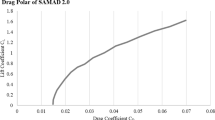Abstract
The flight control law design for tanker should ensure that the closed-loop response can meet the aerial refueling mission requirements. In order to reveal the movement characteristics of the tanker and the handling characteristics of the pilot in aerial refueling, the flight path capture and hold under gust disturbance task is designed as the demonstration maneuver mission to evaluate the flying qualities for tanker in aerial refueling task, which is based on the design requirements of maneuvering tasks used in mission-oriented flying qualities assessment. By analyzing the flight path tracking and holding requirements of the tanker in aerial refueling mission, the relevant parameters that reflect the response characteristics of the tanker in pitch and roll axes are put forward. The ground flight simulation test based on mission-oriented flight quality assessment is conducted, and the test pilot’s assessment results based on Cooper-Harper rating and PIO scales are obtained for different flight control law configurations. The suggested requirements of the closed-loop response characteristics of the pitch and roll axes of the tanker are put forward, which can be specifications for the aerial refueling mode flight control design of tanker.
Similar content being viewed by others
References
Thomas P R, Bhandari U, Bullock S, et al. Advances in air to air refuelling. Prog Aerosp Sci, 2014, 71: 14–35
Su Z, Wang H, Shao X, et al. A robust back-stepping based trajectory tracking controller for the tanker with strict posture constraints under unknown flow perturbations. Aerosp Sci Tech, 2016, 56: 34–45
Bloy A W, Khan M M. Modeling of the receiver aircraft in air-to-air refueling. J Aircraft, 2002, 38: 393–396
Ro K, Kamman J W. Modeling and simulation of hose-paradrogue aerial refueling systems. J Guidance Control Dyn, 2010, 33: 53–63
Waishek J, Dogan A, Blake W. Derivation of the dynamics equations of receiver aircraft in aerial refueling. J Guidance Control Dyn, 2009, 32: 586–598
Dogan A, Blake W. Maneuverability of large receiver of different size and weight in aerial refueling. J Guidance Control Dyn, 2014, 37: 1880–1896
Lee J H, Sevil H E, Dogan A, et al. Estimation of receiver aircraft states and wind vectors in aerial refueling. J Guidance Control Dyn, 2014, 37: 265–276
Bloy A W, Lea K A. Directional stability of a large receiver aircraft in air-to-air refueling. J Aircraft, 1995, 32: 453–455
Iloputaife O, Svoboda G, Bailey T. Handling qualities design of the C- 17A for receiver-refueling. In: Guidance, Navigation, and Control Conference. San Diego, 1996. AIAA-96-3746
Specification M. MIL-F-8785C. Military Specification Flying Qualities of Piloted Airplanes, 1980
Standard M. Flying qualities of piloted aircraft. MIL-STD-1797A ed, 1990
Prieto Saiz L. A330 multi role tanker transport: The way of certification. In: 2008 U.S. Air Force T&E Days. Los Angeles, 2008. AIAA- 2008-1635
Bradley J, Emerson K. The testing of fixed wing tanker and receiver aircraft to establish their air-to-air refuelling capabilities. AGARDAG- 300, 1992, Flight Test Techniques Series - Volume 11
Roberts L. KC-135R low altitude air refueling flight test program. In: Orbital Debris Conference: Technical Issues andFuture Directions. Baltimore, 1990. AIAA-90-1265-CP
Klyde D H, Mitchell D G, Latimer K J. Development of the probeand- drogue handling qualities demonstration maneuver. J Guidance Control Dyn, 1999, 22: 528–535
Taschner M J. A handling qualities investigation of conventional, rate command/attitude hold, and attitude command/attitude hold response types in the probe and drogue air refueling task. Air Force Institute of Technology, 1994
Taschner M J. A handling qualities investigation of selected responsetypes for the air refueling Task. In: 20th Atmospheric Flight Mechanics Conference. Baltimore, 1995. AIAA-95-3428-CP
Mitchell D G, Hoh R H, Aponso B L, et al. Proposed incorporation of mission-oriented flying qualities into MIL-STD-1797A. 1994
Leggett D, Cord T. Flying qualities demonstration maneuvers. In: AIAA Guidance, Navigation, and Control Conference. Portland, 1994. AAIA-94-2133-CP
Wang L, Guo Y, Zhang Q, et al. Suggestion for aircraft flying qualities requirements of a short-range air combat mission. Chin J Aeronautics, 2017, 30: 881–897
Miller C J. Nonlinear dynamic inversion baseline control law: Architecture and performance predictions. In: AIAA Guidance, Navigation, and Control Conference. Portland, 2011
Klyde D H, Aponso B L, Mitchell D G, et al. Development of demonstration maneuvers for aircraft handling qualities evaluation. In: 22nd Atmospheric Flight Mechanics Conference. New Orleans, 1997. AIAA-97-3653
Wilson D J, Riley D R, Citurs K D. Aircraft maneuvers for the evaluation of flying qualities and agility. Volume 2: Maneuver descriptions and selection guide. Technical Report. AD-A273685. 1993
Latimer K J. A limited investigation of probe-and-drogue aerial refueling tasks to evaluate closed-loop handling qualities (HAVE GAS II). Technical Report. AFFTC-TR-97-13. 1997
Wilson D J, Riley D R, Citurs K D, et al. Aircraft maneuvers for the evaluation of flying qualities and agility. Volume 1: Maneuver development process and initial maneuver set. Technical Report. New Haven: Wright Laboratory, 1993. AD-A273913
Harper R P, Cooper G E. Handling qualities and pilot evaluation. J Guidance Control Dyn, 1986, 9: 515–529
Acosta D M, Yildiz Y, Craun R W, et al. Piloted evaluation of a control allocation technique to recover from pilot-induced oscillations. J Aircraft, 2015, 52: 130–140
Author information
Authors and Affiliations
Corresponding author
Rights and permissions
About this article
Cite this article
Yue, T., Zhang, Q., Yin, H. et al. Suggested closed-loop response characteristics for tanker in aerial refueling via mission-oriented evaluation. Sci. China Technol. Sci. 62, 490–501 (2019). https://doi.org/10.1007/s11431-018-9325-4
Received:
Accepted:
Published:
Issue Date:
DOI: https://doi.org/10.1007/s11431-018-9325-4




